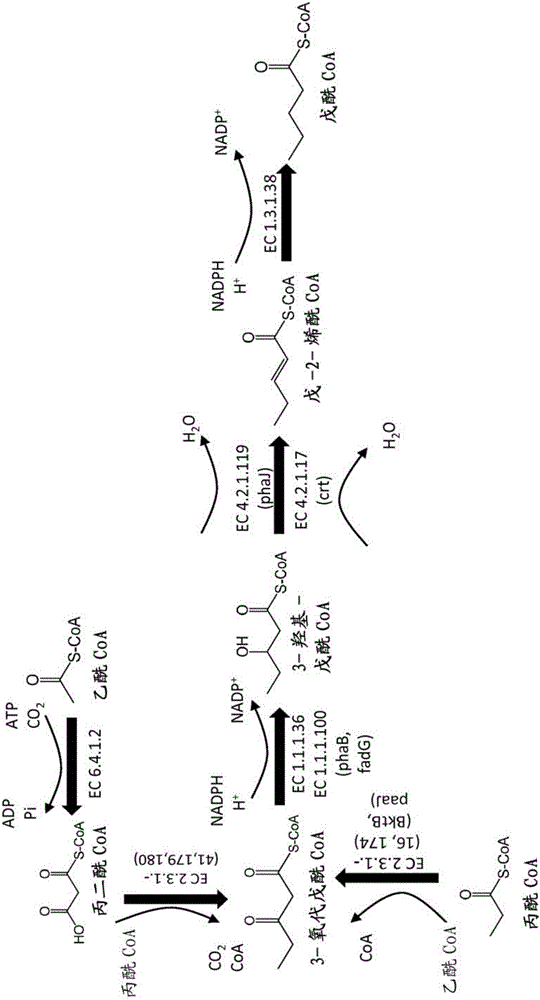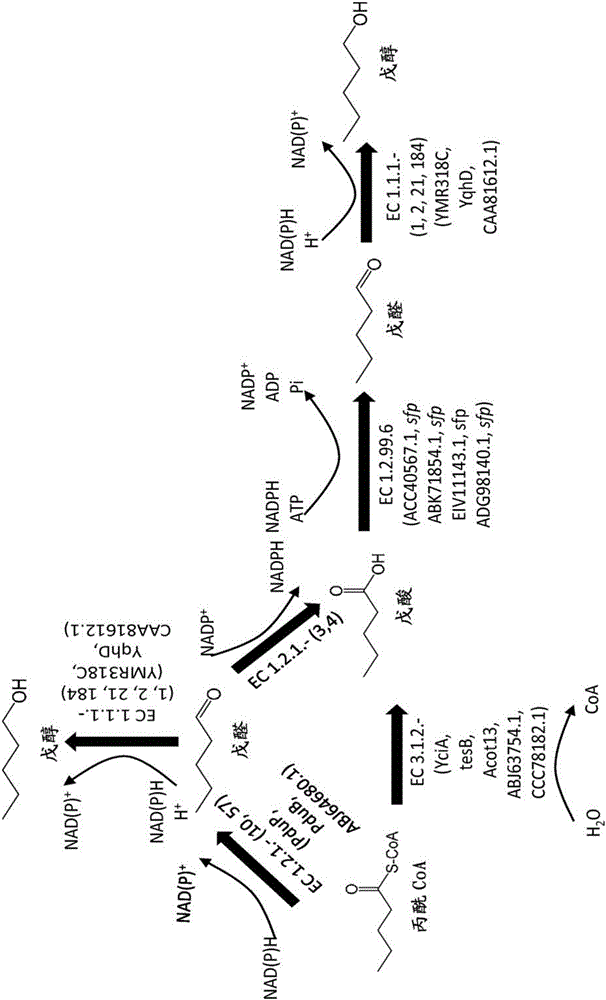Methods, reagents and cells for biosynthesizing compounds
An active, hydroxyalkyl technology, applied in the field of recombinant host cells and recombinant hosts
- Summary
- Abstract
- Description
- Claims
- Application Information
AI Technical Summary
Problems solved by technology
Method used
Image
Examples
Embodiment 1
[0368] Enzymatic activity of omega-transaminase using glutaric semialdehyde as a substrate and forming 5-aminovaleric acid
[0369] Nucleotide sequences encoding N-terminal His-tags were added to the genes from Chromobacterium violaceum and Rhodococcus sphaeroides encoding ω-transaminases of SEQ ID NOs: 8 and 10, respectively (see Figure 10 ), allowing the production of N-terminal HIS-tagged omega-aminotransferases. Each resulting modified gene was cloned into the pET21a expression vector under the control of the T7 promoter, and each expression vector was transformed into a BL21[DE3] E. coli host. The resulting recombinant E. coli strains were grown in 250 mL shake flask cultures containing 50 mL LB medium and antibiotic selection pressure at 37°C with shaking at 230 rpm. Each culture was induced overnight at 16°C with 1 mM IPTG.
[0370] Pellets from each induced shake flask culture were harvested by centrifugation. Each pellet was resuspended and lysed by sonication. C...
Embodiment 2
[0376] Enzymatic activity of carboxylic acid reductase using 5-hydroxyvaleric acid as a substrate and forming 5-hydroxyvaleraldehyde
[0377] Nucleotide sequences encoding His-tags were added to M. marinum, M. smegmatis, M. smegmatis, Segniliparus from M. marinum, M. smegmatis, M. smegmatis, Segniliparus encoding carboxylic acid reductases of SEQ ID NOs: 2-4, 6 and 7, respectively Genes of rugosus, M. marseii, and Segniliparus rotundus (GenBank accession numbers ACC40567.1, ABK71854.1, EFV11917.1, EIV11143.1, and ADG98140.1, respectively) (see Figure 10 ), allowing the production of N-terminal HIS-tagged carboxylate reductases. Each modified gene was cloned into the pET Duet expression vector, both under the control of the T7 promoter, along with the sfp gene encoding the His-tagged phosphopantethelin transferase from Bacillus subtilis. Each expression vector was transformed into a BL21[DE3] E. coli host. Each resulting recombinant E. coli strain was grown in a 250 mL shake...
Embodiment 3
[0382] Omega-transaminase activity for 5-aminopentanol to form 5-oxopentanol
[0383] Nucleotide sequences encoding N-terminal His-tags were added to Chromobacterium violaceum, Pseudomonas aeruginosa, Pseudomonas syringae, Rhodobacter sphaeroides, Escherichia coli encoding ω-transaminases of SEQ ID NOs: 8-13, respectively Bacillus and Vibrio fluvius genes (see Figure 10 ), allowing the production of N-terminal HIS-tagged omega-aminotransferases. The modified gene was cloned into the pET21a expression vector under the T7 promoter. Each expression vector was transformed into a BL21[DE3] E. coli host. Each resulting recombinant E. coli strain was grown in a 250 mL shake flask containing 50 mL of LB medium and antibiotic selection pressure at 37°C with shaking at 230 rpm. Each culture was induced overnight at 16°C with 1 mM IPTG.
[0384] Pellets from each induced shake flask culture were harvested by centrifugation. Each pellet was resuspended and lysed by sonication. Cell...
PUM
 Login to View More
Login to View More Abstract
Description
Claims
Application Information
 Login to View More
Login to View More - R&D
- Intellectual Property
- Life Sciences
- Materials
- Tech Scout
- Unparalleled Data Quality
- Higher Quality Content
- 60% Fewer Hallucinations
Browse by: Latest US Patents, China's latest patents, Technical Efficacy Thesaurus, Application Domain, Technology Topic, Popular Technical Reports.
© 2025 PatSnap. All rights reserved.Legal|Privacy policy|Modern Slavery Act Transparency Statement|Sitemap|About US| Contact US: help@patsnap.com



